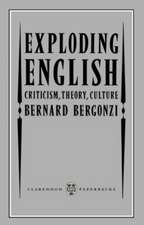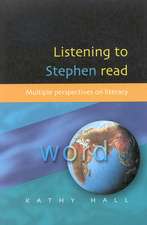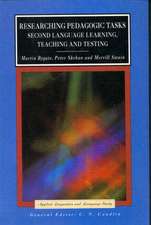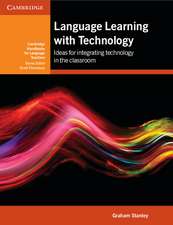Understanding Language Classroom Contexts: The Starting Point for Change
Autor Dr Martin Wedell, Angi Malderezen Limba Engleză Paperback – 10 apr 2013
| Toate formatele și edițiile | Preț | Express |
|---|---|---|
| Paperback (1) | 225.06 lei 6-8 săpt. | |
| Bloomsbury Publishing – 10 apr 2013 | 225.06 lei 6-8 săpt. | |
| Hardback (1) | 773.39 lei 6-8 săpt. | |
| Bloomsbury Publishing – 10 apr 2013 | 773.39 lei 6-8 săpt. |
Preț: 225.06 lei
Preț vechi: 258.53 lei
-13% Nou
Puncte Express: 338
Preț estimativ în valută:
43.06€ • 45.09$ • 35.72£
43.06€ • 45.09$ • 35.72£
Carte tipărită la comandă
Livrare economică 10-24 aprilie
Preluare comenzi: 021 569.72.76
Specificații
ISBN-13: 9781441133076
ISBN-10: 1441133070
Pagini: 248
Ilustrații: 40
Dimensiuni: 156 x 234 x 15 mm
Greutate: 0.39 kg
Editura: Bloomsbury Publishing
Colecția Bloomsbury Academic
Locul publicării:London, United Kingdom
ISBN-10: 1441133070
Pagini: 248
Ilustrații: 40
Dimensiuni: 156 x 234 x 15 mm
Greutate: 0.39 kg
Editura: Bloomsbury Publishing
Colecția Bloomsbury Academic
Locul publicării:London, United Kingdom
Caracteristici
Helps language teaching professionals to understand how teaching and learning is influenced by context
Notă biografică
Angi Malderez is a freelance education consultant, and Honorary Senior Fellow of the School of Education, University of Leeds, UK.Martin Wedell is Senior Lecturer and Head of International Education at the University of Leeds, UK.
Cuprins
Introduction 1. Components of Contexts 2. Exploring Culture 3. Language and Languages in Education 4. From Cultures to Methods 5. From Methods to Approaches 6. Teachers and Learners: As Part of and Creators of their Context 7. Teachers and Learners: As 'Products of their Context 8. Schools and Classrooms: Physical and Cultural Contexts 9. Planning and Implementing Classroom Change 10. Conclusions: On Understanding Language Classroom Contexts and the Process of Change Index
Recenzii
This volume discusses the subtle interconnectedness of the language classroom and change. By means of thought-provoking questions and tasks, the authors repeatedly turn their monologue into a dialogue with the readers to help them understand that they are not only the products but also the creators of their classroom contexts. While specifically directed at teachers of English, this book is an eye-opener for anyone who has a stake in education. And who doesn't?
What I like most about this book is that the authors have managed to facilitate readers in understanding the complex and dynamic nature of language classroom contexts by incorporating their own processes of analyzing a large amount of real data. In this way, not only do they ease our journey of exploring culture, but they also give us a fantastic practical tool for our own research analysis.
I have found this book illuminating as it is exciting in exploring and foregrounding the contextual issues that teachers of English Language and, indeed all language teachers as well as school leadership practitioners grapple with in their efforts to provide a conducive environment for learners. It is easy to identify with, extremely educative and the style used is both 'soft' and friendly to the reader. The book inspires the reader to reflect more on the dynamics and the multiple layers of socio-cultural contexts in schools thus raising the inquisitiveness of the readers on the relevance of adopting universal conceptualisations of language teaching and school leadership in a fast changing world.
Some notion of context underlies almost every kind of thinking or discussion in language education, especially English language education (ELE). The term 'context' has by now acquired such connotations in ELE that it is no more possible to give any adequate equivalent to it. But while it is widely acknowledged that any aspect of ELE has intricate links with 'context', there hasn't been any comprehensive exploration of context per se.It is, therefore, a matter of great significance that at last here is a book that takes up 'context' in its own right and deals exclusively with it. This is an excellent resource for everyone - from practicing teachers to administrators and policy makers - and absolutely essential reading if you are involved in change. The most important strength of the book is that it attempts to compile 'the whole picture' of context from many perspectives - historical and descriptive, macro and micro, insider and outsider, and practical and theoretical. Another key strength is numerous tasks, thinking questions and authentic illustrations which constantly remind and help readers to situate the discussion in their own contexts. If you are looking for a good grounding in 'context', this is the book to begin with!
The book has a user-friendly, approachable design and is very readable . . . the authors' survey of the available literature is excellent . . . I know I shall be referring to Understanding Language Classroom Contexts in the months and years to come, whether for my own interest, for training purposes, or for reminders of questions and models to bear in mind when involved in change projects.
The authors do a service to the field by beginning a thorough investigation into the meaning of context.
What I like most about this book is that the authors have managed to facilitate readers in understanding the complex and dynamic nature of language classroom contexts by incorporating their own processes of analyzing a large amount of real data. In this way, not only do they ease our journey of exploring culture, but they also give us a fantastic practical tool for our own research analysis.
I have found this book illuminating as it is exciting in exploring and foregrounding the contextual issues that teachers of English Language and, indeed all language teachers as well as school leadership practitioners grapple with in their efforts to provide a conducive environment for learners. It is easy to identify with, extremely educative and the style used is both 'soft' and friendly to the reader. The book inspires the reader to reflect more on the dynamics and the multiple layers of socio-cultural contexts in schools thus raising the inquisitiveness of the readers on the relevance of adopting universal conceptualisations of language teaching and school leadership in a fast changing world.
Some notion of context underlies almost every kind of thinking or discussion in language education, especially English language education (ELE). The term 'context' has by now acquired such connotations in ELE that it is no more possible to give any adequate equivalent to it. But while it is widely acknowledged that any aspect of ELE has intricate links with 'context', there hasn't been any comprehensive exploration of context per se.It is, therefore, a matter of great significance that at last here is a book that takes up 'context' in its own right and deals exclusively with it. This is an excellent resource for everyone - from practicing teachers to administrators and policy makers - and absolutely essential reading if you are involved in change. The most important strength of the book is that it attempts to compile 'the whole picture' of context from many perspectives - historical and descriptive, macro and micro, insider and outsider, and practical and theoretical. Another key strength is numerous tasks, thinking questions and authentic illustrations which constantly remind and help readers to situate the discussion in their own contexts. If you are looking for a good grounding in 'context', this is the book to begin with!
The book has a user-friendly, approachable design and is very readable . . . the authors' survey of the available literature is excellent . . . I know I shall be referring to Understanding Language Classroom Contexts in the months and years to come, whether for my own interest, for training purposes, or for reminders of questions and models to bear in mind when involved in change projects.
The authors do a service to the field by beginning a thorough investigation into the meaning of context.















